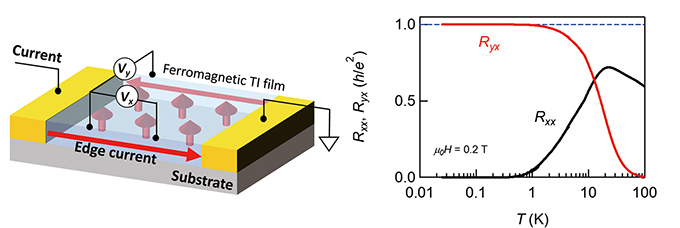Outline

Our team studies quantum transport phenomena in solids. Using thin-film crystals of materials with strong spin-orbit interactions or materials with nontrivial topology in their band structures, we fabricate devices in which electronic correlations and geometrical phases play important roles, and measure electrical transport properties under extreme environments such as low temperatures and strong magnetic fields. Through these studies, we aim to discover new quantum phenomena that will expand our understanding of condensed matter physics, and to explore electronic and spintronic functions that utilize them, opening the door to new technologies.
Research Fields
Physics, Engineering, Materials Sciences
Keywords
Topological insulators
Topological superconductors
Thin films and interfaces
Quantum transport phenomena
Anomalous Hall effect
Results
Development of quantum resistance standard devices using magnetic topological insulators
Topological insulators are a group of materials that have insulating interiors and metallic surface states. In magnetic topological insulators doped with magnetic elements, the resistance perpendicular to the current (Hall resistance) becomes the quantum unit of electrical resistance, the von Klitzing constant (h/e2, where h is Planck’s constant and e is the elementary charge). This phenomenon known as the quantum anomalous Hall effect occurs even in the absence of an external magnetic field. Therefore, it is expected to work as a new type of quantum resistance standard that does not require a strong magnetic field. We have fabricated high-quality magnetic topological insulator heterostructure thin films by molecular beam epitaxy and confirmed that the Hall resistance value matches the von Klitzing constant with an accuracy of eight digits. It is expected that the elimination of the need for a strong magnetic field will lead to the miniaturization of quantum resistance standards.

(Left) Schematic illustration of the quantum anomalous Hall effect device. (Right) Temperature dependence of the longitudinal (Rxx) and Hall (Ryx) resistance.




